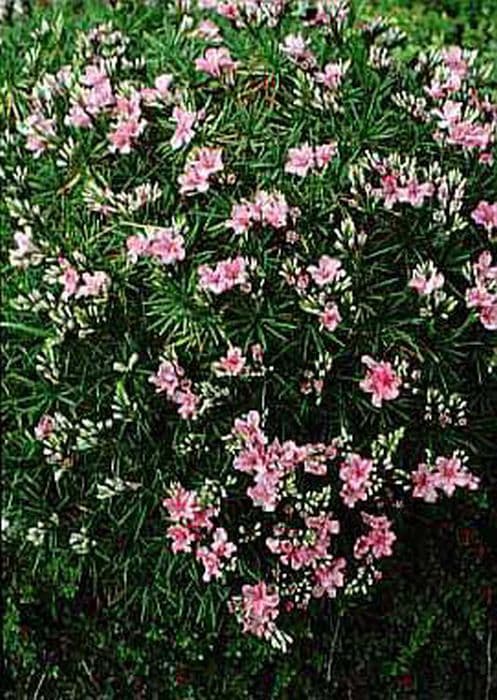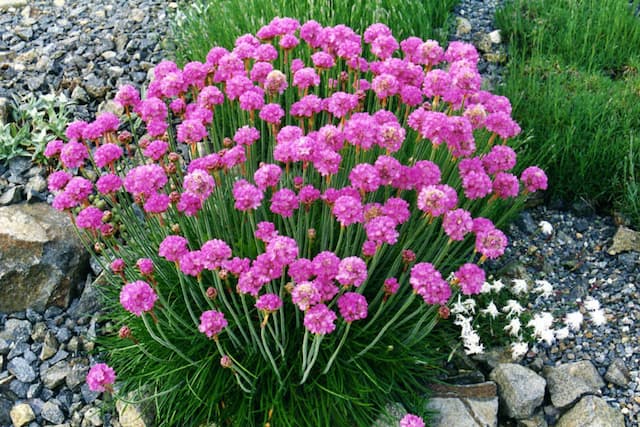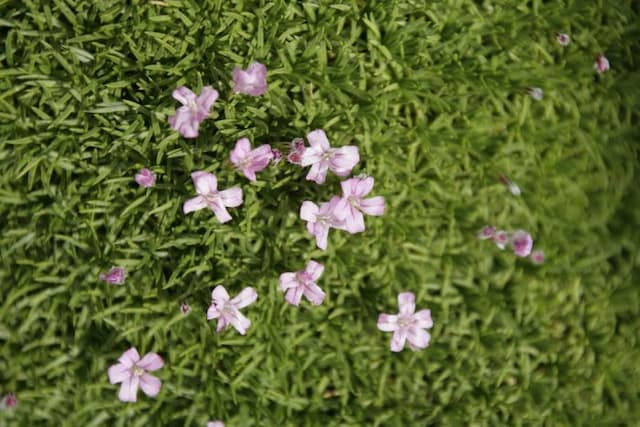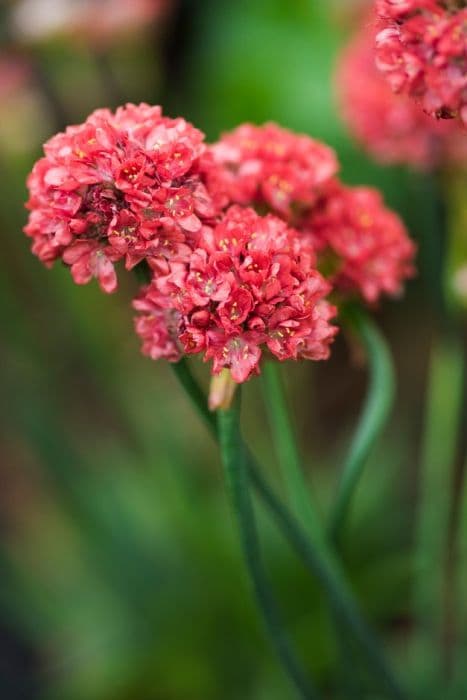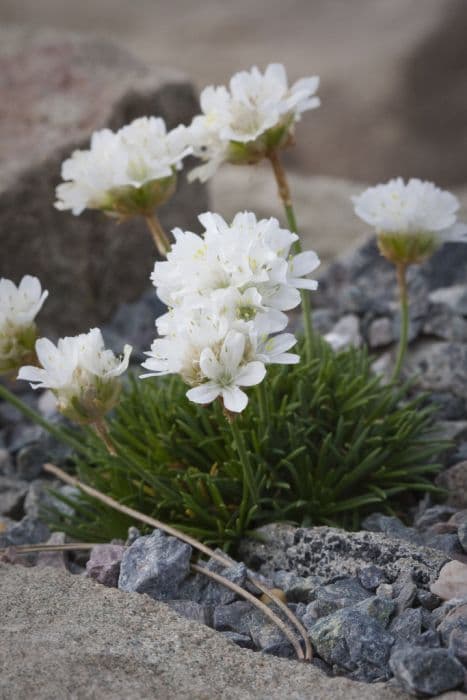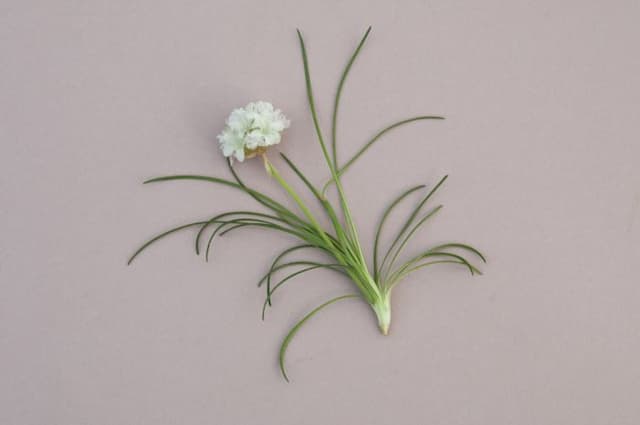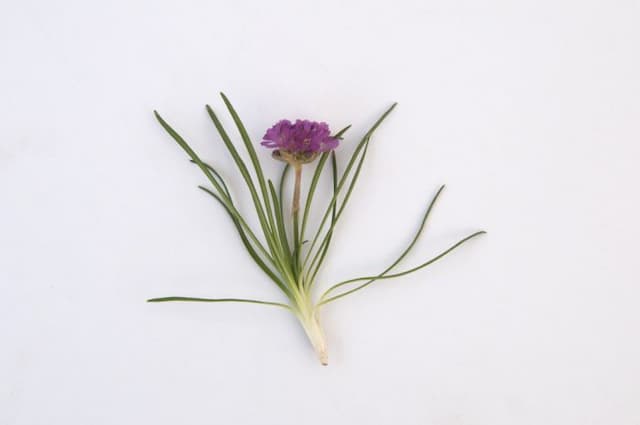Prickly Thrift Acantholimon venustum

ABOUT
The plant, known commonly as Prickly Thrift, has a unique and striking appearance that captures the eye. It proudly displays dense tufts of long, needle-like leaves that are a strong, silvery-gray hue. These leaves often have a spiny texture which contributes to the name "Prickly" Thrift. The foliage alone makes this plant visually appealing, lending it a soft yet architectural quality that makes it stand out in any landscape setting. In addition to its attractive foliage, the Prickly Thrift produces cheerful flowers that bring a burst of color to its otherwise muted appearance. These blooms are typically pink and appear on the ends of stems that slightly rise above the foliage. The flowers are small, rounded, and tightly clustered, resembling little cushions that hover above the needle-like leaves. They add to the decorative nature of the plant, making it a desirable choice for gardens or ornamental displays. The overall appearance of the Prickly Thrift is one of contrast and resilience, with the combination of its spiky silver foliage and soft pink flowers. This blend of toughness with beauty is what makes the Prickly Thrift an appealing plant to many garden enthusiasts.
About this plant
 Names
NamesFamily
Plumbaginaceae
Synonyms
Prickly Thrift, Spiny Thrift
Common names
Acantholimon venustum
 Toxicity
ToxicityTo humans
Acantholimon venustum, commonly known as prickly thrift, does not have a well-documented profile of toxicity to humans. There is limited information available on the consequences of ingesting this plant or any known toxins present within it. As with any plant, individual allergies or sensitivities may occur, but without specific knowledge of toxins, it's not possible to outline symptoms of poisoning. Caution should always be exercised with unknown plants as some may cause irritation or allergic reactions.
To pets
Prickly thrift or Acantholimon venustum is not widely recognized for being toxic to pets. However, due to the general lack of comprehensive data regarding its toxicity, it is advisable to prevent pets from ingesting this plant. If a pet does consume prickly thrift and exhibits unusual symptoms, seek veterinary care. Remember, what is harmless to humans can sometimes be toxic to animals, so it's always best to err on the side of caution.
 Characteristics
CharacteristicsLife cycle
Perennials
Foliage type
Evergreen
Color of leaves
Green
Flower color
Pink
Height
1 feet (0.30 meters)
Spread
1 feet (0.30 meters)
Plant type
Shrub
Hardiness zones
5
Native area
Turkey
Benefits
 General Benefits
General Benefits- Aesthetic Appeal: Adds a unique texture and visual interest to gardens with its needle-like foliage and pink to purple flowers.
- Drought Tolerance: Highly adaptable to arid conditions, making it suitable for xeriscaping and low-water gardens.
- Cold Resistance: Tolerates cold temperatures, which allows it to survive in a variety of climates.
- Soil Adaptability: Can thrive in poor soil conditions, including rocky and sandy soils, reducing the need for soil amendments.
- Low Maintenance: Requires minimal care once established, making it ideal for gardeners looking for low-effort plants.
- Pollinator Attraction: Flowers attract bees and other pollinators, supporting local ecosystems.
- Erosion Control: Its root system can help stabilize soil and prevent erosion on slopes.
- Deer Resistance: Not typically favored by deer, which helps prevent damage to the plant and the surrounding vegetation.
- Long Blooming: Often has a lengthy blooming period, providing extended color and interest in the garden.
- Compact Growth: Naturally grows in a compact form, which prevents it from overpowering other plants in garden designs.
 Medical Properties
Medical PropertiesThis plant is not used for medical purposes.
 Air-purifying Qualities
Air-purifying QualitiesThis plant is not specifically known for air purifying qualities.
 Other Uses
Other Uses- Acantholimon venustum, commonly known as Prickly Thrift, can be used in rock gardens to provide aesthetic appeal due to its unique texture and form.
- Prickly Thrift can serve as a low-maintenance ground cover in areas with dry, poor soils where other plants might struggle to survive.
- This plant's dense, cushion-like growth habit can help prevent soil erosion on slopes and banks in landscape settings.
- Due to its resistance to pests and diseases, Prickly Thrift can be used as a companion plant to protect more vulnerable species in a garden.
- The stark contrast between its green-gray foliage and pink to purple flowers can be used to create striking visual compositions in xeriscapes.
- Prickly Thrift's unique flowering spikes can be dried and used in flower arrangements, maintaining their color and form for extended periods.
- In regions with strong winds, Acantholimon venustum can act as a wind barrier for other plants due to its sturdy, compact growth.
- Gardeners may use this plant to create a natural border or edge in a garden path due to its uniform and neat growth pattern.
- Creative landscaping can incorporate Prickly Thrift into crevice gardens, taking advantage of its tolerance for sparse soils and enhancing the garden's texture.
- Prickly Thrift's spiky leaves can act as a deterrent against small animals, such as rodents, helping to protect other more delicate garden plants.
Interesting Facts
 Feng Shui
Feng ShuiThe plant Acantholimon venustum is not used in Feng Shui practice.
 Zodiac Sign Compitability
Zodiac Sign CompitabilityThe plant Acantholimon venustum is not used in astrology practice.
 Plant Symbolism
Plant Symbolism- Resilience: Acantholimon venustum, commonly known as Prickly Thrift, is known for its ability to survive in harsh, rocky environments, which can symbolize the ability to endure difficult conditions and to persevere through challenges.
- Protection: The sharp, spiny foliage of the Prickly Thrift serves as a protective barrier. This characteristic can symbolize safeguarding oneself or others from potential threats.
- Beauty in Adversity: Despite its rugged habitat, the Prickly Thrift blooms with beautiful flowers, representing the concept that beauty and grace can exist in even the most trying situations.
 Water
WaterThe prickly thrift, commonly known as Acantholimon venustum, requires minimal watering due to its drought-tolerant nature. Allow the soil to dry out between waterings, which roughly translates to about once every two weeks. When you do water, do so deeply, providing around half a gallon for outdoor plants or 2-4 ounces for potted plants to ensure moisture reaches the root zone. Avoid overwatering, as the prickly thrift is susceptible to root rot in soggy soil. During the dormant winter season, reduce watering frequency significantly.
 Light
LightPrickly thrift thrives best in full sunlight conditions, making it an excellent choice for a spot that receives at least six hours of direct sunlight each day. This light preference makes it ideal for rock gardens, south-facing windowsills, or any unobstructed location where it can bask in the sun's rays uninterrupted.
 Temperature
TemperaturePrickly thrift is cold-hardy and can tolerate temperatures down to about 5°F, but it flourishes in a temperature range of 60°F to 75°F. Avoid exposing it to temperatures above 85°F, as extreme heat can stress the plant. Ideal growth occurs within this moderate temperature range, typical of its native alpine habitats.
 Pruning
PruningPruning prickly thrift is mainly for shaping and removing any damaged or dead foliage. Prune sparingly, ideally in early spring before new growth begins, to maintain a compact and healthy plant. Avoid heavy pruning, as this can damage the plant. It is typically enough to trim back any errant spikes or remove dead flowers after blooming.
 Cleaning
CleaningAs needed
 Soil
SoilPrickly Thrift requires a well-draining soil mix composed primarily of sand or a gritty substrate to mimic its natural rocky habitat; mix in some compost for organic content. The ideal pH for Prickly Thrift is slightly acidic to neutral, around 6.0 to 7.0.
 Repotting
RepottingPrickly Thrift should be repotted every two to three years to refresh the soil and accommodate root growth, but it can tolerate being root-bound to some extent.
 Humidity & Misting
Humidity & MistingPrickly Thrift thrives in dry conditions and does not require high humidity; it is well-suited to the low humidity found in typical home environments.
 Suitable locations
Suitable locationsIndoor
Place in bright light, low humidity, avoid overwatering.
Outdoor
Plant in full sun, well-draining soil, protect from excess moisture.
Hardiness zone
5-9 USDA
 Life cycle
Life cycleAcantholimon venustum, commonly known as "Prickly Thrift," begins its life cycle as a seed, dispersing into the soil in its native habitat. After a period of dormancy, which may be broken by factors such as temperature changes or scarification, germination occurs and a small seedling emerges. The seedling grows slowly, establishing a deep root system and developing a rosette of spiky, evergreen leaves. As the plant matures, it forms a woody base and starts to produce distinctive pink to purple flowers on tall, erect spikes during its flowering period, which typically occurs in late spring or early summer. After pollination, often facilitated by insects, the flowers develop into seed capsules containing new seeds, ready to be dispersed by wind or animal movement. The Prickly Thrift is a perennial plant and will enter a phase of dormancy during harsh conditions, only to resume growth and flowering in subsequent seasons, thus completing its life cycle.
 Propogation
PropogationPropogation time
Spring-Early Summer
Propogation: Acantholimon venustum, commonly known as Prickly Thrift, is best propagated by seed. The optimal time for sowing seeds is typically in spring when temperatures are mild, as this allows for a full growing season. To propagate Prickly Thrift by seeds, one should sow the seeds on the surface of a well-draining seed starting mix, as they need light to germinate. Generally, covering them with a thin layer of soil can hinder their growth. It's important to keep the soil moist, but not waterlogged, and to maintain a temperature around 70°F (approximately 21°C). Seeds may take several weeks to germinate, and once the seedlings have developed a few true leaves, they can be carefully transplanted to individual pots or their final location in the garden.
